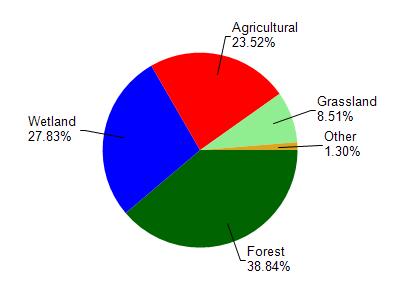Taylor
No
No
No
Fish and Aquatic Life
Overview
The physical configuration of this 45 acre, 53 foot deep lake creates significant management problems. Winterkill has occurred primarily because of the lack of adequate turnover, or mixing, of the lake during spring and fall. The lake also experiences frequent algal blooms. Because of these conditions, the Richter Lake Association has installed an aeration system. Winter dissolved oxygen monitoring is conducted annually by the Department and kept on file at the Park Falls DNR office.
A fish consumption advisory exists for largemouth bass (WDNR, 1997). To confirm the need for this advisory, additional largemouth bass should be collected for tissue analysis (Amrhein). A self-help volunteer should be found to collect water quality data. Additionally, a lakes planning grant would expand the amount and types of data needed to better assess the conditions of Richter Lake (Ryan).
Date 1999
Author Aquatic Biologist
Historical Description
Richter Lake is a soft water, seepage lake with an intermittent outlet to an unnamed feeder of Joe Creek. Fish present include northern pike, walleyes, largemouth bass, perch, bluegills, black crappies, rock bass, pumpkinseeds, black, and brown bullheads, and white suckers. The shoreline vegetation is entirely upland hardwood. The littoral bottom is approximately 60 percent gravel, 20 percent sand and 20 percent muck. Furbearer use is not significant, and waterfowl use is minor. There is public access with limited parking on the north end of the lake. Public frontage amounts to 0.20 miles of Chequamegon National Forest land. Private lake shore developments consists of one resort, one boat rental place and 15 cottages.
Source: 1970, Surface Water Resources of Taylor County Richter Lake, T31N, R2W, Section 11 Surface Acres = 44.8, Maximum Depth = 50 feet, M.P.A. = 34 ppm.
Date 1970
Author Aquatic Biologist
Condition
Wisconsin has over 84,000 miles of streams, 15,000 lakes and milllions of acres of wetlands. Assessing the condition of this vast amount of water is challenging. The state's water monitoring program uses a media-based, cross-program approach to analyze water condition. An updated monitoring strategy (2015-2020) is now available. Compliance with Clean Water Act fishable, swimmable standards are located in the Executive Summary of Water Condition in 2018. See also the 'monitoring and projects' tab.
Reports
Recommendations
Management Goals
Wisconsin's Water Quality Standards provide qualitative and quantitative goals for waters that are protective of Fishable, Swimmable conditions [Learn more]. Waters that do not meet water quality standards are considered impaired and restoration actions are planned and carried out until the water is once again fishable and swimmable
Management goals can include creation or implementation of a Total Maximum Daily Load analysis, a Nine Key Element Plan, or other restoration work, education and outreach and more. If specific recommendations exist for this water, they will be displayed below online.
Monitoring
Monitoring the condition of a river, stream, or lake includes gathering physical, chemical, biological, and habitat data. Comprehensive studies often gather all these parameters in great detail, while lighter assessment events will involve sampling physical, chemical and biological data such as macroinvertebrates. Aquatic macroinvertebrates and fish communities integrate watershed or catchment condition, providing great insight into overall ecosystem health. Chemical and habitat parameters tell researchers more about human induced problems including contaminated runoff, point source dischargers, or habitat issues that foster or limit the potential of aquatic communities to thrive in a given area. Wisconsin's Water Monitoring Strategy was recenty updated.
Grants and Management Projects
Monitoring Projects
| WBIC | Official Waterbody Name | Station ID | Station Name | Earliest Fieldwork Date | Latest Fieldwork Date | View Station | View Data |
|---|
| 1760000 | Richter Lake | 10005817 | Richter Lake | 4/17/1994 | 3/12/2024 | Map | Data |
| 1760000 | Richter Lake | 613190 | Richter Lake - Deep Hole | 5/2/2003 | 10/14/2024 | Map | Data |
| 1760000 | Richter Lake | 10020237 | Richter Lake -- Ramp | 7/23/2015 | 7/23/2015 | Map | Data |
|

Watershed Characteristics
Richter Lake is located in the Trappers and Pine Creeks watershed which is 134.31 mi². Land use in the watershed is primarily forest (38.80%), wetland (27.80%) and a mix of agricultural (23.50%) and other uses (9.80%). This watershed has 181.16 stream miles, 550.88 lake acres and 15,489.14 wetland acres.
Nonpoint Source Characteristics
This watershed is ranked Low for runoff impacts on streams, Not Available for runoff impacts on lakes and Medium for runoff impacts on groundwater and therefore has an overall rank of Medium. This value can be used in ranking the watershed or individual waterbodies for grant funding under state and county programs.However, all waters are affected by diffuse pollutant sources regardless of initial water quality. Applications for specific runoff projects under state or county grant programs may be pursued. For more information, go to surface water program grants.